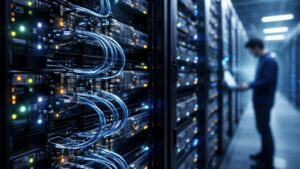The increase in water scarcity is causing industries to continuously face challenges in handling their wastewater. Furthermore, the conventional techniques are currently demonstrating their ineffectiveness. Nonetheless, Zero Liquid Discharge has come up as a new effective technique. This revolutionary technology aims at eliminating liquid discharges and creating closed loops for water that can reuse in production processes. This method is not just better for the environment but also financially beneficial. This article will go through the basics of Zero Liquid Discharge, its benefits/ challenges, and developments in this industry.
Zero Liquid Discharge: Covering The Basics
Zero Waste Water Treatment signifies a change from the normal practices of dealing with industrial wastewater. It also focuses on separating all water from waste streams, leaving behind solid waste. So, let us dive deeper and see the process that makes ZLD a reality:
Pretreatment and Filtration
Initially, ZLD implies taking out all suspended materials such as oils and other pollutants present in wastewater. To do this, it utilizes filtration methods such as ultrafiltration and nanofiltration techniques. Furthermore, these processes protect the downstream equipment and improve the efficiency of the treatment steps ahead. It also reduces the environmental impact and costs on operations later on.
Concentration and Evaporation
Following the pretreatment process, wastewater now enters into the concentration phase. In this, technologies like reverse osmosis or mechanical vapor recompression evaporators come into the light. Furthermore, these systems are effective in removing the bulk of the remaining water. So, this majorly reduces the volume of liquid waste. Moreover, the process concentrates the dissolved solids into a smaller stream leading to the final stage of treatment. Hence, this step is crucial for minimizing the energy in need for the complete recovery of water.
Crystallization and Solidification
The final step of the process in ZLD is crystallizing the concentrated brine solution to take out the last traces of water. Furthermore, crystallizers use thermal or mechanical processes to make solid crystals from dissolved salts and more. So, this step makes the water recovery process complete. It also produces solid residues that can come in use and also be disposed of. As a result, the crystallization phase holds key significance in transforming the liquid waste into manageable solid byproducts.
Benefits and Challenges of ZLD Implementation in Industrial Wastewater Management
The implementation of Zero Liquid Discharge provides great advantages for the industries, however, it also has its unique challenges. Moreover, to have an understanding of both is crucial to consider the technology. So, let’s see some major benefits and challenges ahead:
Benefits of Zero Liquid Discharge in Industrial Applications:
Environmental Protection
ZLD systems are effective in getting rid of wastewater discharge. So, this helps to prevent pollution of water bodies and soil. Furthermore, with the reduction of almost 95% of the wastewater, this technology majorly reduces freshwater consumption, addressing the issues of water scarcity. Moreover, it safeguards the local ecosystem and protects the groundwater resources. It also helps organizations to fall in line with the stringent environmental regulations.
Resource Recovery
Zero Liquid Discharge processes give way to the recovery of valuable materials from wastewater streams. It includes minerals and salts. Furthermore, this turns waste into a marketable product leading to more revenue streams. Moreover, resource recovery prompts circular economy principles. It reduces the overall environmental footprint of industrial operations. Additionally, it increases the value extracted from raw materials and minimizes waste, leading to resource efficiency as well.
Regulatory Compliance and Corporate Image
Implementing ZLD technology aids organizations in meeting and exceeding regulatory requirements. So, it makes them environmental leaders. Furthermore, this proactive approach increases corporate reputation, leading to great stakeholder relations and an increase in market share. Moreover, ZLD adoption shows a commitment to sustainability making it a powerful tool for differentiating your brand and customer loyalty.
Challenges of Zero Liquid Discharge in Industrial Applications:
High Energy Consumption
Zero Liquid Discharge systems need a major energy input, primarily in the phase of evaporation and crystallization. So, this high demand for energy can increase operational costs and lead to an even larger carbon footprint. As a result, a balance between environmental benefits with energy requirements is needed with more efficient Zero Liquid Discharge technologies for sustainable water management. Additionally, industries should consider trade-offs between conserving water and energy use when using Zero Liquid Discharge solutions.
Complex Operation and Maintenance
ZLD systems need skilled operators and regular maintenance to prevent significant issues. It includes scaling, fouling, or corrosion. Furthermore, this complexity can be even more challenging for smaller industries or those in regions with limited access to such expertise. Moreover, ensuring consistent performance while managing the intricacies of ZLD operations requires ongoing training, monitoring, and also interventions to maintain efficiency.
High Initial Investment
Making use of a ZLD system involves major upfront costs. It includes purchasing equipment, installation, and modifications in the facility. So, this high investment can be a barrier for smaller enterprises or those in challenging economic conditions. Even though Zero Liquid Discharge gives long-term savings, the extended payback period can make it difficult to justify the investment when faced with competing capital expenditure priorities.
Innovations Driving ZLD Forward in Industrial Wastewater Management
The field of Zero Liquid Discharge is evolving rapidly. Moreover, new technologies and approaches are emerging consistently to address the limitations and expand applicability across industries. So, let us see some of these technologies ahead:
Advanced Membrane Technologies
Researchers are making more efficient and durable reverse osmosis membranes that can handle higher concentrations of dissolved solids. Furthermore, these advancements show the promise of reducing energy consumption in the concentration phase of ZLD processes. As a result, this makes the technology more accessible to a range of industries. These membrane materials are key to overcoming the current limitations and improving the efficiency of the system.
Thermal Efficiency Improvements
Innovative hybrid systems that combine thermal and membrane technologies are emerging to optimize energy usage in ZLD processes. Furthermore, these systems make use of the strengths of both technologies. Hence, it improves water recovery rates. Moreover, by integrating waste heat utilization and advanced heat exchange mechanisms, these systems push the boundaries of possibilities for ZLD technology.
AI and Automation in ZLD Systems
AI and Machine learning are getting integrated into ZLD system to optimize operations and predict the needs for maintenance. Furthermore, these smart systems can adjust the parameters of treatment in real-time. This is as per the influent quality, costs of energy, and other factors. As a result, it can maximize efficiency and minimize the downtime. Moreover, predictive maintenance algorithms can help prevent failures of equipment and reduce operational costs making Zero Liquid Discharge more reliable and cost-effective.
To Sum Up
Zero Liquid Discharge is a major leap forward in industrial wastewater management. It gives a sustainable solution to the most pressing environmental challenges. Moreover, with the advancements in technology and decrease in costs, it can become the industry standard across sectors. Attending the forthcoming Industrial Water & Wastewater Management Summit is something you should think about if you want to learn more about these innovative water management technologies and other strategies. It is scheduled for September 26–27, 2024, in Frankfurt, Germany. It’s an occasion that offers a special chance to network with prominent figures in the field, investigate useful ideas and solutions, and stay one step ahead of the competition. So, why wait? Learn more and register right away!




